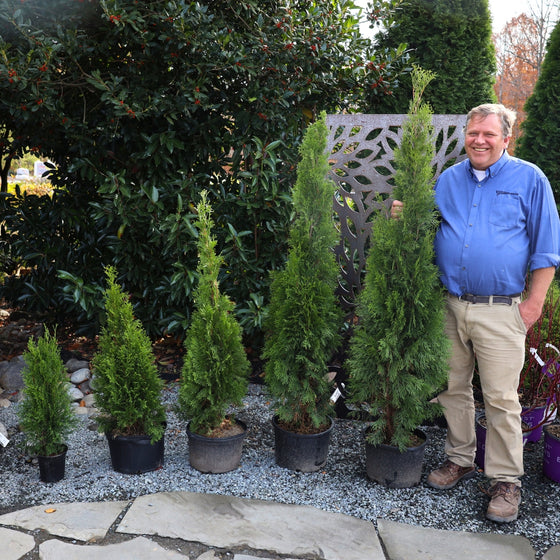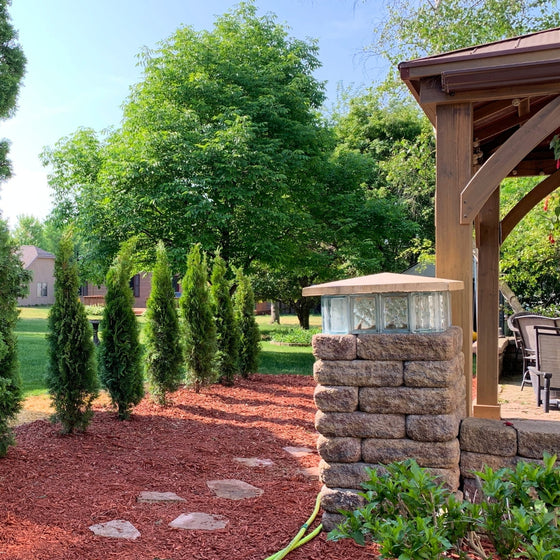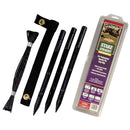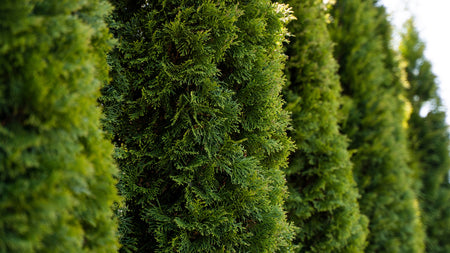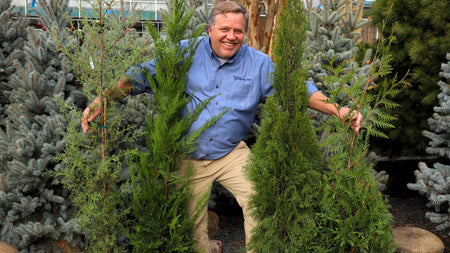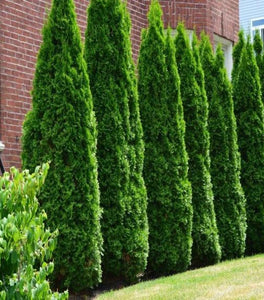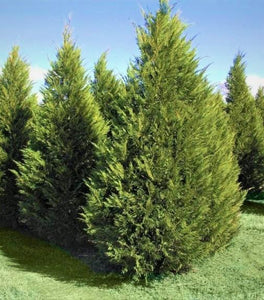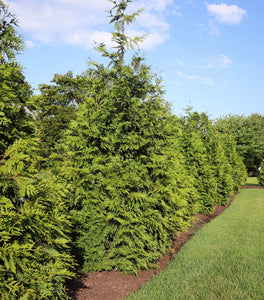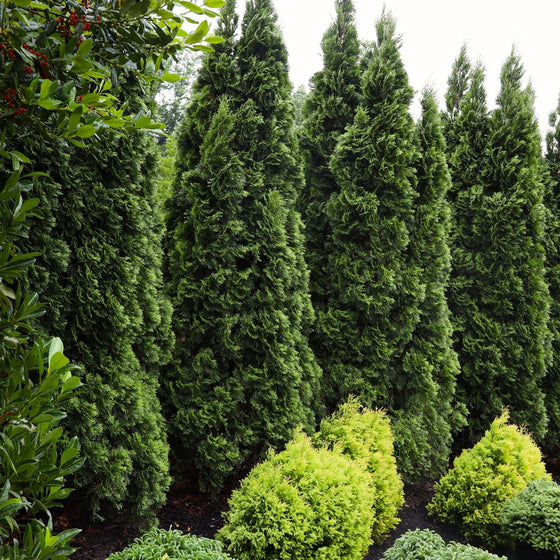
Images Depict Mature Plants
Emerald Green Arborvitae: Narrow Evergreen Privacy That Actually Fits
Emerald Green Arborvitae (Thuja occidentalis ‘Smaragd’) is the classic narrow privacy tree homeowners trust when they want year-round screening without overpowering the yard. This pyramidal evergreen typically matures around 10–15 feet tall and 3–4 feet wide, creating a tall, columnar form that tucks neatly along fences, property lines, and driveways.
Its rich, emerald-green foliage stays vibrant through winter instead of bronzing, so your hedge looks crisp and intentional in every season. Whether you’re softening a neighbor’s view, lining a driveway, or framing the front walk, Emerald Green delivers tidy structure and instant curb appeal.
A Space-Saving Columnar Evergreen
Thuja ‘Smaragd’ grows in a naturally narrow, pyramidal habit with dense, fan-like sprays of foliage and very little tip-flop or winter gap. Most landscapes can expect a mature size of about 12–14 feet tall and 3–4 feet wide, depending on climate and care.
Growth is steady but controlled, averaging approximately 12 inches per year once established, which makes it far easier to manage than super-fast-growing giants that quickly outgrow tight spaces.
Plant a single specimen as a vertical accent in mixed borders, or repeat several in a row for a living wall that feels intentional instead of overwhelming.
Sun-Loving, Adaptable, and Cold Hardy
Emerald Green Arborvitae thrives in full sun to light shade and performs best in moist, well-drained soils, but it’s surprisingly adaptable to a wide range of soil types, from loamy and rich to sandy or slightly clay-heavy.
Hardy in USDA Zones 3–8, it tolerates cold winters down to roughly -30°F and holds its foliage color beautifully through snow and ice.
Regular watering during the first couple of seasons helps it root deeply and handle moderate drought once established. Like all arborvitae, foliage and twigs are considered toxic if ingested, so keep pets and children from chewing on branches.
Privacy, Structure, and Driveway Drama
Emerald Green Arborvitae is a workhorse for tight spaces, providing real privacy. Plant a row 2–3 feet apart for a fast-forming solid hedge or 3–4 feet apart for a slightly looser, more defined look.
It’s ideal for narrow side yards, property lines, pool screens, and as a driveway border that feels formal but not stuffy. Its upright, evergreen form also makes a strong backdrop for flowering shrubs and perennials, letting hydrangeas, roses, and pollinator plants shine against that rich green curtain. For patios and entries, younger plants can even be grown in large containers to frame a doorway or define an outdoor room.

| Hardiness Zone: | 3-8 |
|---|---|
| Mature Height: | 12 to 15 feet |
| Mature Width: | 3 to 4 feet |
| Sunlight: | Full sun to Part Shade |
| Foliage Color: | Glossy bright green |
| Growth Form: | Dense upright and conical |
| Soil Conditions: | Grow best in average, medium moisture, well-drained soils. Will not tolerate extremely dry conditions. |
| Water Requirements: | Regular watering first 1–2 years; moderate drought tolerance once established |
| Resistance: | Cold-hardy; generally pest and disease resistant; not reliably deer-proof |
| Landscape Uses: | Privacy hedges, screening, foundation plantings, driveway borders, accent specimens, large containers |
How to Care for Emerald Green Arborvitae (Thuja ‘Smaragd’)
Once you buy an Emerald Green Arborvitae, make sure to read about the care instructions that are required and recommended to keep this plant healthy and thriving.
How should I plant Emerald Green Arborvitae?
Start by choosing a sunny to lightly shaded spot with well-drained soil and enough room for the tree’s mature height and width. Loosen the planting area and dig a hole roughly twice as wide as the root ball but only as deep as the root mass, so the top of the root ball sits level with or slightly above the surrounding soil. Gently tease apart any circling roots, place the tree in the hole, and rotate it so the best side faces your main view. Backfill with the native soil you removed, breaking up large clumps and firming lightly as you go to eliminate air pockets. Once the hole is backfilled, water slowly and thoroughly to settle the soil around the roots. Apply a 2–3 inch layer of mulch over the root zone, keeping it a couple of inches away from the trunk to prevent rot. For a hedge, repeat this process for each plant along your line, using a straight edge or string line to keep spacing and alignment consistent. Plant in spring or fall in most climates so the roots can establish before summer heat or deep winter cold.
How often should I water Emerald Green Arborvitae after planting?
During the first growing season, consistent moisture is the key to helping Emerald Green Arborvitae establish deep, resilient roots. Water deeply 1–2 times per week, depending on weather and soil type, aiming to soak the root ball and the surrounding soil instead of just sprinkling the surface. In hot, dry, or windy conditions, you may need to increase the frequency, especially for container-grown plants or trees planted near hardscape where heat reflects. After the first full year, your watering schedule can relax. In most average garden soils, Emerald Green Arborvitae will only need supplemental water during extended dry spells, particularly in summer and early fall. Established trees have moderate drought tolerance, but they will always perform better with occasional deep soakings than with frequent, shallow watering. In winter, water sparingly—just enough to avoid prolonged dry soil when the ground is not frozen.
When should I fertilize Emerald Green Arborvitae?
Fertilize Emerald Green Arborvitae in early spring, just before or as new growth begins to push, using a balanced, slow-release fertilizer formulated for trees and shrubs. This timing ensures nutrients are available when the tree is actively growing, supporting dense foliage and a strong root system. Follow label directions carefully and avoid over-fertilizing, which can stress the plant and encourage weak, overly soft growth. If you prefer a more natural approach, focus on building healthy soil instead of feeding heavily. An annual top-dressing of compost or well-rotted organic matter around (but not against) the trunk adds gentle nutrition and improves soil structure. Mulching with shredded bark or leaf mold helps conserve moisture, moderate soil temperature, and slowly feeds the soil food web, which in turn supports long-term health and vigor.

When and how should I prune Emerald Green Arborvitae?
Prune Emerald Green Arborvitae in late spring to early summer once the new flush of growth has begun to harden off but before the intense heat of midsummer. Use clean, sharp hand pruners or hedge shears to lightly trim the outer foliage, maintaining the tree’s natural narrow pyramid shape. Always keep the top slightly narrower than the base so sunlight can reach lower foliage and prevent thinning at the bottom. Avoid cutting back into old, bare wood where there are no green shoots, as arborvitae do not reliably resprout from deep cuts. For long-term maintenance, think of pruning as gentle shaping rather than a major haircut. Lightly shear or selectively snip a couple of times per season if you like a very formal hedge, or once a year if you prefer a more natural look. If a branch is damaged by snow, ice, or an animal, remove it cleanly back to a lateral branch. Over time, regular, light pruning will keep your hedge dense, uniform, and easy to manage.
Additional Information
If you’re looking for a go-to evergreen that delivers real privacy without eating your whole yard, Emerald Green Arborvitae is tough to beat. This narrow, upright Thuja slots beautifully along fences, property lines, and driveways, giving you a dense, year-round green wall in a footprint that’s only about 3–4 feet wide at maturity. With honest, steady growth, cold-hardiness through zones 3–8, and simple care, it’s a smart choice for first-time homeowners and seasoned landscapers alike. Use it as a clean backdrop for flowering shrubs, to soften the edge of a patio, or to replace that tired old fence with living structure.

